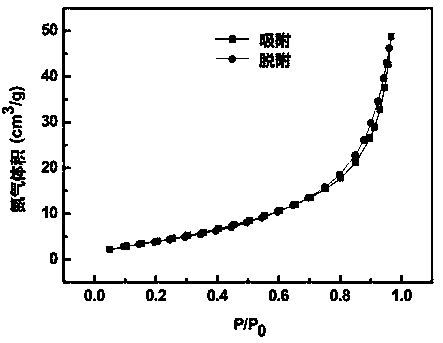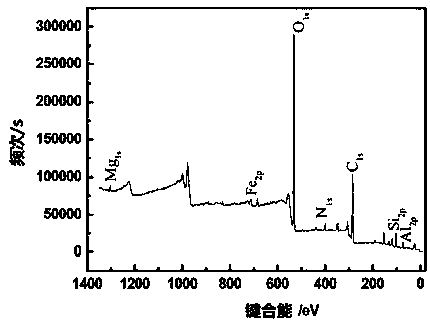Preparation method and application of nitrogen-doped sludge compost visible light photocatalytic material
A photocatalytic material and visible light technology, applied in the field of photocatalytic materials, can solve the problem of incomplete carbonization of sludge, and achieve the effect of accelerating the hydrothermal carbonization process, avoiding agglomeration and large specific surface area.
- Summary
- Abstract
- Description
- Claims
- Application Information
AI Technical Summary
Problems solved by technology
Method used
Image
Examples
Embodiment 1
[0037] In this example, the preparation method of nitrogen-doped porous carbon visible light catalytic material using urea as a sludge composting product supplemented with nitrogen source is as follows:
[0038] Take 100g of compost products with a carbon-to-nitrogen ratio of 35, freeze-dry them for 48 hours to obtain dry solid particles, grind them through a 40-mesh sieve, put 2.5g of the resulting solids into a 100ml polytetrafluoroethylene-lined stainless steel autoclave, and add 50ml of deionized Water, take it out after reacting in a high-temperature oven at 180°C for 5 hours, cool to room temperature, take out the cooled mixture and centrifuge, wash the obtained solid with deionized water and ethanol several times in turn, dry it at 60°C for 24 hours, and then grind The sludge-based carbon visible light catalytic material is obtained.
[0039] The preparation method of the compost product in this example is as follows: the sludge aerobic compost product uses dewatered sl...
Embodiment 2
[0041] In this example, urea is used as a sludge composting product to supplement nitrogen source to prepare nitrogen-doped porous carbon see photocatalytic material. The preparation method is as follows:
[0042] As in Example 1, the catalyst obtained by comparing sludge composting products under different conditions is to the degradation reaction rate of Rhodamine B (such as Figure 4 shown). Depend on Figure 4 It can be seen that under light conditions, the catalyst prepared by adding urea as a supplementary nitrogen source has the best effect, and the catalyst prepared without urea has the second best effect, while the degradation efficiency of the catalyst on rhodamine B is the worst under the dark condition.
[0043] The catalytic degradation performance of nitrogen-doped sludge-based materials added with urea is significantly better than that of sludge-based materials without urea, because the metals (Fe, Zn, Ti, etc.) in the sludge aerobic composting products are hyd...
Embodiment 3
[0045] In this example, urea is used as the sludge composting product to supplement nitrogen source to prepare nitrogen-doped porous carbon see photocatalytic material. The preparation method is as follows:
[0046] As in Example 1, the difference is that the range of deionized water added to the polytetrafluoroethylene-lined stainless steel autoclave is 5 ~ 50ml, and the catalysts obtained by adding different amounts of water are compared to the degradation reaction of rhodamine B under visible light irradiation. rate (eg Figure 5 shown), by Figure 5 It can be seen that the photocatalyst prepared with 50ml of water has the best effect.
[0047] When the amount of added water increased from 5ml to 50ml, the catalytic effect of the obtained sludge-based material was better. The increase of the liquid-solid ratio mainly enhances the solubility of water, and promotes the dehydration and decarbonylation reactions of the main components of organic matter, making the hydrotherma...
PUM
 Login to View More
Login to View More Abstract
Description
Claims
Application Information
 Login to View More
Login to View More - R&D
- Intellectual Property
- Life Sciences
- Materials
- Tech Scout
- Unparalleled Data Quality
- Higher Quality Content
- 60% Fewer Hallucinations
Browse by: Latest US Patents, China's latest patents, Technical Efficacy Thesaurus, Application Domain, Technology Topic, Popular Technical Reports.
© 2025 PatSnap. All rights reserved.Legal|Privacy policy|Modern Slavery Act Transparency Statement|Sitemap|About US| Contact US: help@patsnap.com



